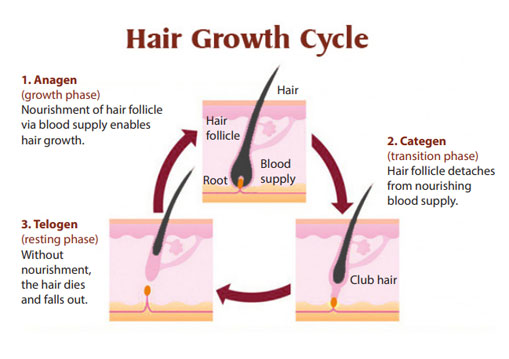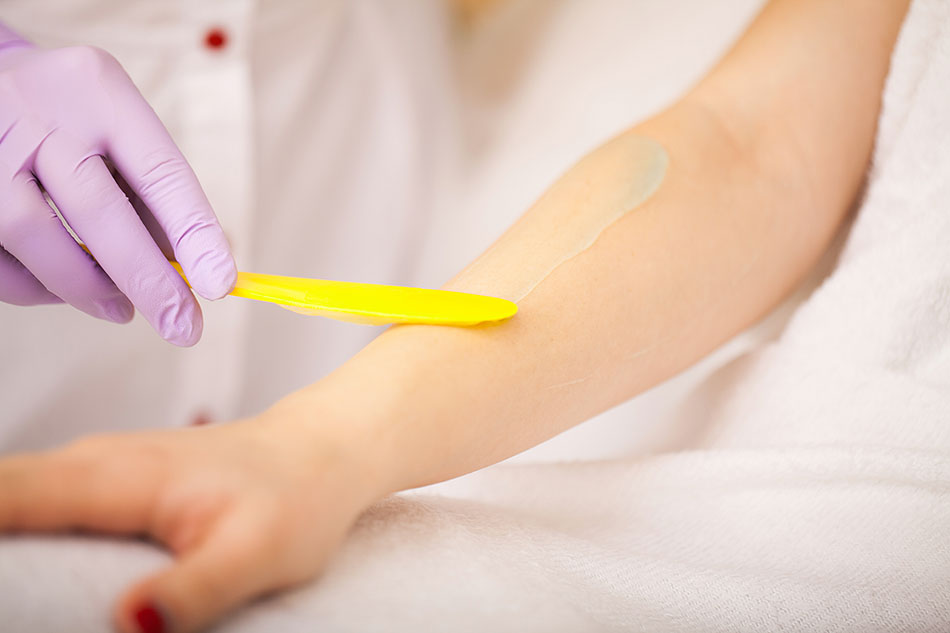Lasers can remove unwanted hair faster, more comfortably and more reliably than many other methods. Whether you are a man or a woman, young or old, laser hair removal is an alternative to plucking, shaving, waxing, electrolysis or chemical depilatories.
How does hair grow?
Age, sex, weight, metabolism, hormones, genetics, ethnicity, medications, location of hair, and the changing of seasons can all affect hair growth. The growth of hair occurs in three phases.
Phase 1: Anagen
Hair’s active growth phase is called anagen and lasts up to several years. The majority of hair is in this phase at any given time. During anagen, the hair has an abundance of melanin.
Phase 2: Catagen
The catagen or regressive phase lasts about 2 to 4 weeks. In this phase, hair stops growing but is not yet shed. About 3 or 4 per cent of body hair is in this phase.
Phase 3: Telogen
Lasting weeks to months, the telogen or resting phase is when hair falls out and a new hair begins to form. At least 10 to 15 per cent of body hair is in this phase.
At any given time, hairs from various parts of the body are at different phases. This cycling prevents all body hair from falling out at the same time and waiting months for hair to grow back.
How do lasers work?
Although laser hair removal is not usually considered permanent, studies have shown that areas where hair is removed by lasers can generally remain hair free longer than by most other methods. Lasers most effectively disable hair that is in the anagen or active growth phase.
Lasers emit a powerful beam of light that is absorbed by the pigment in the hair follicles. The more pigment the hair has i.e. the darker in colour, the more effective the treatment is. The laser pulses for a fraction of a second, just long enough to vaporise the pigment while minimising damage to the surrounding skin. The hair follicles absorb the laser energy impairing the ability to grow new hair.
The Fotona SP Dynamis laser system uses the ultimate laser technology for hair removal, “Avalanche FRAC3®”, which improves hair removal efficacy and reduces patient discomfort.
Which body areas can be treated?
The lasers designed for hair removal can be used on most parts of the body. Many lasers effectively treat large areas. Laser hair removal can treat the:
- Back
- Bikini area
- Chest
- Face, especially the upper lip and chin
- Neck
- Shoulders
Am I a candidate?
It cannot always be predicted who will respond to the laser treatment, or if someone does respond, how long the hair will remain dormant.
Since the energy is released into darker pigmented areas, lasers work best for people with light skin and dark hair. Individuals with dark skin require more treatments while red, grey, white and blonde hairs do not respond as well to lasers, since there is no dark pigment in the hair follicles.
How many treatments will I need?
The number of treatments required depends on skin and hair colour, density and coarseness of the hair, as well as the specific area to be treated.
Because all hair in a treated area may not be in the anagen phase, more than one laser treatment is necessary to remove hair that subsequently enters the growth phase. The desired results vary from person to person. Even though certain hair follicles in a given area have been treated, age and hormones may cause other hair follicles to start growing in the area. If regrowth of hair occurs, the hair is often thinner and lighter in colour.
On average, after three to five treatments, scheduled four to six weeks apart, there will be approximately 50 to 80 per cent less hair growth.
How should I prepare?
- Stay out of the sun for 4 weeks before treatment, protect your skin by using a broad-spectrum sunscreen, SPF 50+.
- Avoid other hair removal methods. Plucking, waxing and electrolysis can disturb the hair follicle and should be avoided at least four weeks before treatment.
- Avoid blood-thinning medications. Ask your doctor about what medications, such as aspirin or anti-inflammatory drugs, or products that can cause photosensitivity, to avoid before the procedure.
- Shave the treatment area. Trimming and shaving is recommended the day before laser treatment. It removes hair above the skin that can result in surface skin damage from burnt hairs, but it leaves the hair shaft intact below the surface.
- Do not take isotretinoin (Accutane®) for 6 months before the start of the treatment.
- Let your doctor know you have a history of herpes infection on the treatment areas. You may need a preventive treatment.
What happens during laser hair removal?
Before the treatment, the area to be treated will be cleansed. Some patients receive a numbing gel. Numbing the area to be treated helps when a small area will be treated and the skin is very sensitive. It takes about one hour for a numbing gel to work.

The laser treatment will take place in a room set up specifically for laser treatments. Everyone in the room must wear protective eyewear during the procedure. To perform the procedure, the skin is held taut and the skin is treated with the laser. Many patients say that the laser pulses feel like warm pinpricks or a rubber band being snapped against the skin.
A laser removes hair by vaporising it. This causes small plumes of smoke that have a sulphur-like smell.
How long your treatment lasts depends on the size of the area being treated. Treating the upper lip takes minutes. If you are having a large area like the back or legs treated, your treatment may last more than an hour.
How long will the results of laser hair removal last?
Most patients remain hair free for months or even years. When the hair regrows, most patients see noticeably less hair than before. The hair also tends to be finer and lighter in colour.
To keep the area free of hair, a patient may need maintenance laser treatments.
What are the possible side-effects?
Side-effects vary with skin type, hair colour, treatment plan and adherence to pre-treatment and post-treatment care. The most common side-effects of laser hair removal include:
- Skin irritation: temporary discomfort, redness and swelling are possible after laser hair removal. Any signs and symptoms typically disappear within several hours;
- Pigment changes: laser hair removal might darken or lighten the affected skin, usually temporarily. Skin lightening primarily affects those who don’t avoid sun exposure before or after treatment and those who have darker skin.
Rarely, laser hair removal can cause blistering, crusting, scarring or other changes in skin texture. Other rare side-effects include greying of treated hair or excessive hair growth around treated areas, particularly on darker skin.
Laser hair removal isn’t recommended for eyelids, eyebrows or surrounding areas, due to the possibility of severe eye injury.
Follow your dermatologist’s instructions
If you have laser hair removal, it is important to start following your dermatologist’s instructions immediately. This helps reduce potential side-effects.
After laser hair removal and between scheduled treatments until at least six weeks after the end of treatment:
- Avoid direct sunlight from hitting your treated skin;
- Do not use a tanning bed, sun lamp, or any other indoor tanning equipment;
- Do not use sunless tanners;
- Protect your skin by using sunscreen. You should apply the sunscreen every day before going outdoors. Apply sunscreen that is broad-spectrum, SPF 50+, and water-resistant.
You will see some redness and swelling after treatment. This often looks like mild sunburn. Applying a cool compress can help reduce your discomfort.